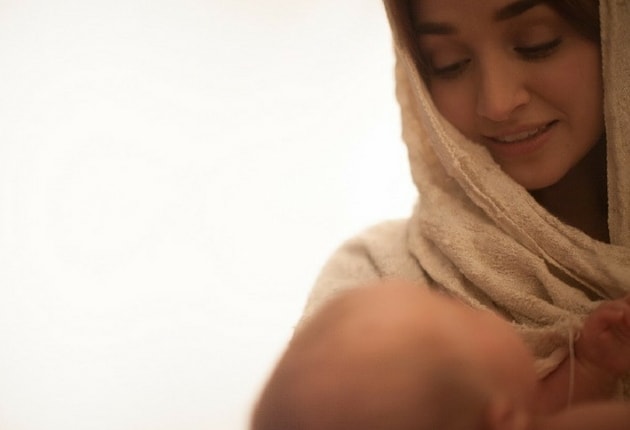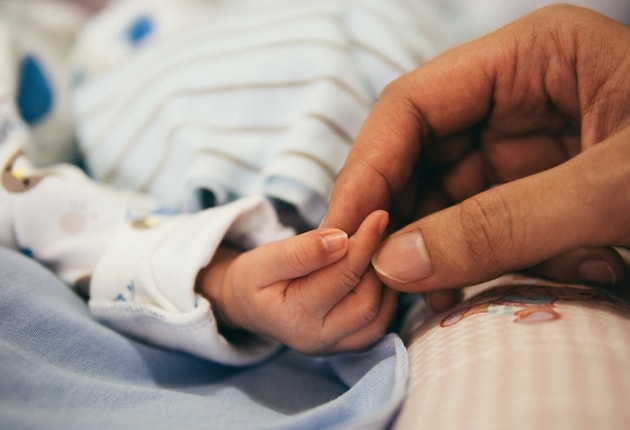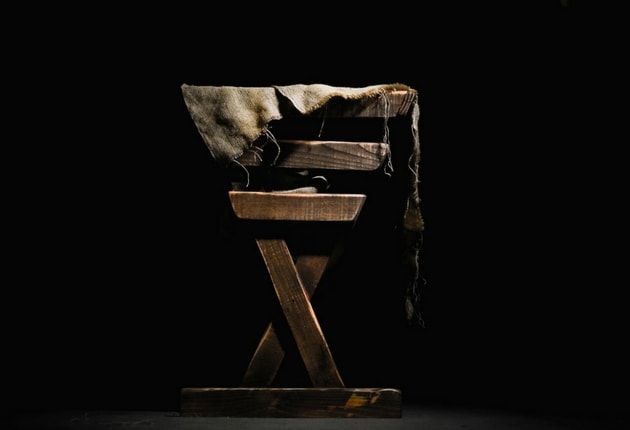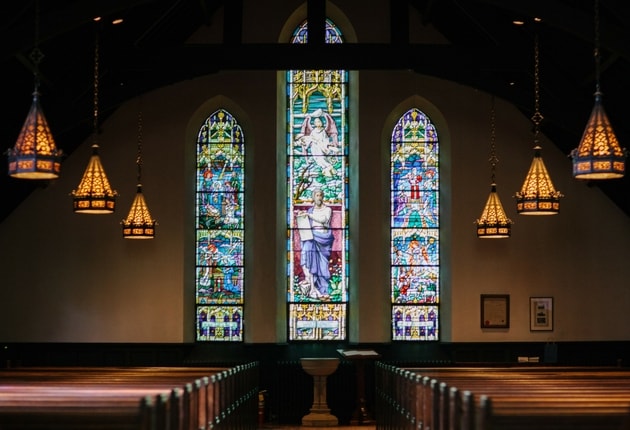December 14, 2017
Jesus from a Mother’s Perspective
Jesus from a Mother’s Perspective
“The Convent of the Blessed Virgin Mary” reads the arched sign above the door. There’s precious little peace and quiet in a mother’s life, but here I am, standing unexpectedly at the entrance to this chapel. The open doors draw me in. I don’t even try to resist.
Once inside I take a deep breath, desperate for life. My spirit wills my body to relax, my mind to leave thoughts of shopping lists and toddler discipline at the door. I take it all in, accept the invitation, and welcome the surprise of solace. Protestant that I am, I fumble uncertainly with the holy water at the doorway. I’m so grateful for this gift of sacred space, I don’t even know how to approach it.
I begin to walk through the gorgeous, empty room. My senses are bombarded in a totally different way than normal. No cacophony of children, no piles of work to do, no phone beeping and twitching in my back pocket. Instead, light and color, candles and incense, tapestries and stained glass. The bread and the wine. The loaves and the fishes.
As I walk, I study the stained-glass windows. Each one in order, leading to the next, telling a story. The first shows the angel Gabriel appearing to Mary, telling her she has been chosen of God, explaining what is to come. The most unexpected of surprise pregnancies. Yet Mary responds with surrender and submission: “I am the servant of the Lord; let it be to me according to your word” (Luke 1:38, esv). This grips me powerfully, from one pregnant woman to another. We have so little control over our lives, over the things we hold dear. Everything irrevocably changes over a few drops of monthly blood—or the lack of it. Our task is to listen, wait, and accept—to surrender. In the hidden womb of the spirit this is the beginning, or the end, of everything.

In the second window, Mary holds the newborn baby Jesus. What isn’t depicted in the sharp lines of the glass is the extended story, but I can readily fill in the details. The hours that came before the serenity. The knife-edge between life and death, the blood and the water. What an astonishing thought: This messiest of human moments is when God breathed his first breath.
Then, the third window. Mary and Joseph finally find their son, who ran off, unbeknownst to them, to teach in the Temple. I see in her face the anxiety, relief, bafflement. My spirit cries out with the realization of the task now ahead—giving up, letting go, humbly realizing that this child is no longer primarily an experience of her own, but a person and identity all his own. This baby may have begun as part of her body, literally one person with herself, but now he will forever be somewhat of a mystery, somehow inaccessible. Though the rest of us mothers have never, will never give birth to the incarnate Word, we too must learn each day to see our children, without defining them. To let go without abandoning. To say, “Your life is not about me but about yourself, and what God is doing in you, and who he has created you to be.” For Mary, and for all of us mamas everywhere, the profound experiences of motherhood give birth to a new soul—and then we must begin to fade into the background. But we treasure up all these things in our hearts.
At the fourth glass I’m stopped in my tracks. Mary, watching her son on the cross. The look on her face is easily recognizable. She confronts a mother’s ultimate fear—the pain and suffering of her child, the breaking of the body and life she so carefully built and nurtured. The God-man mocked, put on trial, carrying a cross, stumbling, dying. Mary watching, watching and weeping. She cannot know the redemption that lies ahead—only that this is the son who learned to walk clutching the hem of her dress.
Entranced by these stories of color and glass I find myself near the altar, standing before a life-sized statue of Mary. She holds her baby, Jesus, who reaches for her face. Joseph stands at her shoulder, protecting them both. They seem close enough to touch, real enough to encounter. I wait, transfixed, trying to understand what it’s all about. Such a familiar scene—the mostfamiliar scene—man, woman, child. A family. Mary, looking so much like the mother, wife, and woman she is . . . with God playing on her lap.
I am struck by the scandalous, beautiful wonder of it all. Mary, Joseph, and Jesus. The everyday intimacy of family. The real-life, flesh-and-blood quality of God’s work in us: his birth, life, and death. Translated to us only inside the language of our own birth, life, and death. God’s most powerful acts, his Incarnation and redemption, did not break out of these most human of actions and identities—but rather worked within them.
For the first time, I look upon God’s work through the eyes of a mother.

Mother of God
Here, where I least expected to find her, I encountered the child-raising spiritual hero I had sought. She isn’t known for charity work, words of wisdom, or tranquil demeanor. All nativity scenes to the contrary, she probably looked just as beleaguered walking through the door of Joseph’s carpenter shop as I would have. Yet we have honored and revered her for thousands of years, simply for submitting faithfully to the task and title given her: mother of God.
The convent’s images drove into my heart a message that has never stopped resounding. Mary and Jesus will never be duplicated, but what strikes me is how ordinary it all seems. The Messiah she carried, God-made-man, was unlike any other—but his redemptive acts were communicated through the common, everyday vernacular of our bodies. From the confusing, exciting, terrifying news that she had conceived, to the agony and ecstasy of birth, through the years of wondering and worrying, to the moment she wept as she held her son’s dead and broken body in her arms.
Can I imagine what it means for a woman to give life to the Son of God? Never.
Can I wrap my mind around the fact that these acts of pregnancy, labor, nighttime feedings, and skinned-knee-kissing are the same doorways God walked through to enter the world? Not hardly.
All at once I see the two stories I know so deeply, side by side. The gospel story my soul has been drinking in since cradle roll, next to the story my adult body has inhabited for a decade. Conception and birth, training up a child, then letting go—alongside the Good News of Creation and Christ, body and blood, bread and wine. Unexpectedly, motherhood becomes the purest window I have to see that when God touched mankind most dramatically—when he walked among us and redeemed us—he did not do so with the supernatural moves of a superhero or mythological god like we were expecting. He used the same life seasons given to each one of us. To reveal himself he came to earth not on a bolt of lightning or on a cloud, but carried in a womb, born of a woman, knitted into flesh and blood—incarnated. To redeem us, this same human body did not triumph majestically but was broken, his flesh torn, his blood spilt—death.
Surrender, and birth. Surrender again, and death. So very, very physical. So absolutely creaturely. These are the bookends of our lives, the entrance and the exit, experienced by all, escaped by none. And God’s redemption played out within them, among them, and through them.
This means that the sacred does not float ethereally beyond the reach of mortals. The sacred has mingled inseparably with the mundane.

Body and Soul
Born and raised on American evangelicalism, I “asked Jesus into my heart” at least a hundred times. This clichéd metaphor expresses a spiritual reality, and we too easily forget there is more here than symbolism. Jesus spiritually alive in my allegorical heart is one thing; the King of Creation cutting baby teeth and going through puberty is something else. Do we actually believe what we proclaim: that God took on flesh and walked among us, with all the humanity that entails?
While I metaphorically have Jesus inmy heart, Mary physically carried God under her heart for nine exhausting months. She labored and pushed, pouring out water and blood and risking her life to give God his first breath. She rocked him to sleep, nursed him from swollen breasts, and sheltered him with the softness of her body. She cut up his food. She placed tiny pieces of fish in his hands and taught God-made-boy to take and eat them. The wine she poured out for him, the bread she broke for him.
These were not acts of salvation, but of ordinary living. And yet, in the hands of God they became the stuff of Incarnation and redemption.
We easily relegate God to the intangible, imagining him hovering over the starry skies but missing him in the faces of our neighbors and the rhythm of our routines. Much easier to believe we could connect to the sacred through meditation than through scrubbing bathroom floors. We sort our lives into two buckets—the physical, bodily, and tangible over here; the spiritual, sacred, and intangible over there. But why?
The answer, at least in part, goes back thousands of years to the ancient teachers. Plato, a Greek philosopher who lived four hundred years before Jesus, saw the spiritual world as more real than the earthly world, which was an illusion, a shadow of the real thing. Saint Augustine, a church bishop who lived about four hundred years after Jesus, weaved these ideas into his own writings, intertwining them with Christian thought.
This idea colored certain traditions of Christian faith for centuries, offering little use for the physical world of creation—including our bodies and their functions. As many saw it, the body simply impeded the soul’s journey and should be suppressed as much as survival allowed. The “fully God” aspects of Jesus were much more compelling than the “fully man.”
The Protestant Reformers wove much of this into their own doctrines and traditions, so in a way our discomfort with the unity and value of body and soul is a family tradition. Like Christmas carols and fruitcake recipes, the suspicion that our bodies cannot be a way to God has been passed down through generations of Catholics and Protestants alike. Spirituality is a way to escape, rather than celebrate, our flesh—or so it seems.
But this is the brainchild of Plato and the Greeks, not of Jesus and the Hebrews. If we dig deeper into our Christian ancestry, we find a very different stream of thought that has also flourished from the beginning. The early church fathers were enamored by the Incarnation—that God actually and literally became part of his Creation. Believing Jesus to be fully God and fully man, they considered the birth of God the ultimate cosmic, world-shattering event. They emphasized that in taking on human form, Jesus united the physical and material with the divine. In accepting our skin, birth, life, and death, he blessed these mortal things and made them somehow immortal, holy, and sacred. In becoming part of his Creation he made perfect his Creation. Not only as a man but as an infant, as a child. As he made his way—fully God and fully boy—through these busy, fleeting days of youth, he brought divine presence and blessing to every stage of human existence.

And as we’ll see later, the Creator who called his handiwork “good” has shown a tremendous tenacity to nurture it. The Good News proclaimed in the Bible from beginning to end has never been that God will get our souls out of this earthly mess, but that he is in the process of redeeming it all—bodies and souls alike.
The miracle is not that Jesus was a human (we see humans every day) or even that he was God. The biblical, Christian miracle is that he was both God and man, divinity fully embodied in flesh and blood. God, connected to his mother by an umbilical cord and passing through the birth canal. The creator of the universe sinking small hands in the muddy ground, dribbling sand from his mouth, getting food in his hair. Trailing after Mary and Joseph, followed in turn by brothers and sisters, running off with friends. He learned to read, to pray, to care for the household animals and do his chores. God himself did these things and more. He did not despise or belittle them—he embraced and blessed them.
If, in becoming human, God somehow blessed the very act of being human, isn’t it possible that in all these daily acts of living he left a sacred residue as well?
That morning at The Convent of the Blessed Virgin Mary, I stepped away from the chaos of my daily life, looking for solace in a silent, sacred room. And yet I found that, in its very act of pointing me to God, the blessed story launched me back into my own life.
The beckoning my heart heard is not to run off into seclusion, shrouding myself in prayers and candles until I find him —as much as I would enjoy that, and as true a calling as it is for some women. No, for mothers and householders everywhere, the beckoning is to go back into the flesh-and-blood world of crumbs-in-the-car-seat and missed-nap tantrums—and find him there.
Right where he met us in the first place.
You’ve been reading from Long Days of Small Things: Motherhood as a Spiritual Discipline by Catherine McNiel. Read the first chapter for free here. Read or learn more from Catherine at catherinemcniel.com. Originally posted on The Disciple-Maker Blog.


